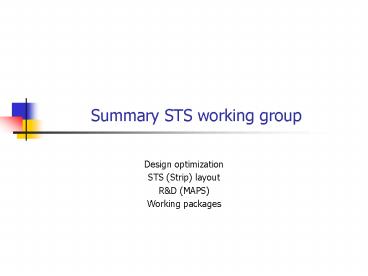Summary STS working group - PowerPoint PPT Presentation
1 / 20
Title:
Summary STS working group
Description:
R&D on monolithic (MAPS, amorphous Si) and. ultra-thin hybrid (Giga-tracker) sensors. ... Smart Detector Reticle. Band Height of non-sensitive part. B2. Sensitive part ... – PowerPoint PPT presentation
Number of Views:67
Avg rating:3.0/5.0
Title: Summary STS working group
1
Summary STS working group
- Design optimization
- STS (Strip) layout
- RD (MAPS)
- Working packages
2
Manpower
- STS activities momentarily not backed by EU
funding - FP6 I3 (SOSDET)
- RD on monolithic (MAPS, amorphous Si)
andultra-thin hybrid (Giga-tracker) sensors. - not funded in favor of diamond ? standard
technologically!! - FP6 Design close call
- STS foreseen for second round (i.e. 2005)
- now cancelled in favor of proposals from first
round - Total manpower in STS project of O(1 FTE)
3
Generic simulation
- Design as of now
- 7 stations at 5,10,20,40,60,80,100 cm from target
- 100 mm (1,2) and 200 mm (3-7) thick
- 10, 20 mm resolution in both coordinates
- Needed for proposal
- Simulation including pad, strip structure
- Optimized configuration
4
Design optimization
STS group
Tracking groups
Mainframe
Algorithms
Digitizers
MAPS Michaels talk
Design Optimization
Strip Tatianas talkValery
Final configuration
5
Si strip STS_4 Layout
20 cm
Valery Savielev, Obninsk State Univ.
-20 cm
Read out
6
Si strip STS_6 Layout
40 cm
Valery Savielev, Obninsk State Univ.
4cm
- 4cm
-40 cm
Read out
7
Digitization result
Tatiana Galatyuk, GSI/Kiev
3-d STS
5-th STS
4-th STS
number of hits
7-th STS
6-th STS
number of zone
8
RD
- MAPS IReS, LEPSI, (GSI)
- radiation tolerance
- readout speed
- Driven by common interest between NLC and CBM
community - Strip detectors MEPHI, MSU
- Thin double-sided sensors
- Read-out (FEE) chip
- no activity yet due to missing funding
9
Successor1 before and after 1MRad X-Rays
Observations (Priliminary) No significant
influence on gain
T -15C t 200µs
Charge collected in 1 pixel ADC
No significant charge loss
Michael Deveaux, GSI/IReS
Charge collected in 9 pixels ADC
CBM collaboration meeting, GSI Darmstadt, 6-8 Oct
2004, Michael Deveaux (michael.deveaux_at_ires.in2p3
.fr)
10
Smart Detector Reticle
Matrix of Pixel
Band Height of sensitive part
Sensitive part
B1
Control ELN
ADC
Sparcification
Memori-sation
Band Height of non-sensitive part
Control and processing part
B2
- Control and address Electronics
- Fast signal processing and data sparsification ?
Signal digitalisation - Storage threshold values needed during data
sparsification - Surface ratio (B2/B1) must be as small as
possible
Hayet Kebbati, GSI/IReS
11
Towards a Design Proposal
12
The end ...
13
Choice of technology
- Availability
- Minimize own development effort (manpower)
- LHC silicon trackers needed 800 man years RD
- Conservative fall-back solutions for future
technology options
14
Problems / Open questions
- Material budget
- increase to balance position resolution!
- identification of conversion electrons
- Efficiency?
- Realistic simulation for track fragment
reconstruction - Efficiency
- Fake rate
- Magnetic field
- Close pair recognition in the inner tracking
section - Efficiency?
- d-electrons
- Vertex reconstruction
- fast station needed in vacuum?
15
Oleg Rogachevski, conformal mapping
- 5,10,20,40,60,80,100 cm, 3 first stations in
vacuum, 100 mm (1-2) and 200 mm (3-7) thickness. - no delta electrons
- Hit multiplicity for secondaries peaks at 1-2
hits, 40 of the hits in the first two stations
have no other hits and cannot be reconstructed - Efficiency drops from 0.95 to 0.7 below 10 GeV,
efficiency gt 95 if 7 hits are observed. - Matching with inner track segments, which are
incomplete, problematic!!!
16
Sascha Ierusalimov, STS track fitting
- Generic simulation
- Uniform field used
- 100 mm thickness throughout, 20 mm resolution
- best resolution between 1 and 10 GeV 0.7 1
if all hits are present. - Vertex reconstruction
- small systematic shifts lt 1 mm
- s 16-21 mm
- Results from realistic simulation (GEANT-3)
- Problems
- broken tracks
- 2-hit tracks?
- close tracks?
17
G. Osakov, track reconstruction a la LIT
- Old geometry used
- on average 1.62 ghost tracks
- efficiency around 80-90 only
18
Pavel Akishin, Polynominal approximation
- Best resolution reached in this approach. 0.4
19
Pavel Zrelov, Kalman filtering
- 2-dimensional projection
- Very precise starting points needed
- 20 mm resolution assumed
- Parabola used as track model between the detector
stations 5-7
20
Joachim Gläß, Fast tracking
- Fast Hough transform used
- Efficiency only above 1 GeV (cut)
- e amounts to 0.95
- Large ghost rate
- Needed clock cycle 150 MHz
- Total number of processing units 200































